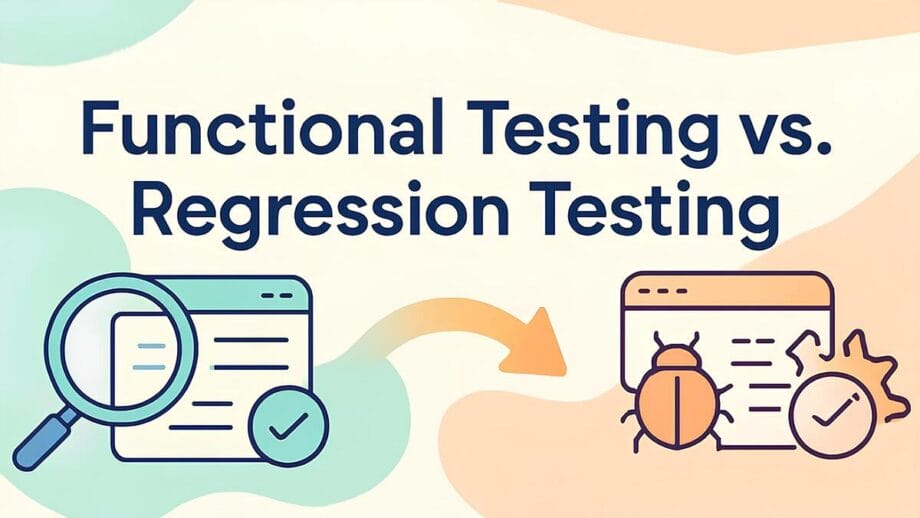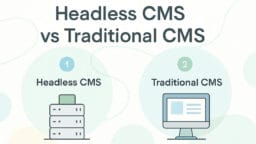The digital age requires software to serve as the central point of interaction between businesses and customers due to fierce commercial competition. The level of user expectation remains extraordinary, while users show zero patience for application flaws. A faulty application will immediately create disappointed users, while simultaneously damaging the brand image and incurring actual monetary losses.
Strategic software testing is a basic requirement in the development lifecycle, despite development receiving greater attention, which highlights its vital role in achieving success. The fundamental elements of quality assurance include functional testing services and regression testing services, among all available testing types. Each method brings necessary value, and its application occurs in different development phases.
Development teams and QA professionals in businesses need to learn functional testing separation from regression testing to provide high-quality, reliable software to their customers. The guide provides an in-depth examination of each methodology, its differences, and effective usage recommendations for 2025 and beyond.
Understanding Functional Testing

The black-box testing method of functional testing checks that software systems fulfill their defined functional requirements or specifications. This testing method determines whether the software meets its required functionality. The application’s features and functions undergo this type of testing using predetermined input values and expected output results, without examining the program’s internal code.
Purpose and Key Aspects
Functional testing serves as the primary goal to check whether every software application function operates as described in its requirement specification. Key aspects include:
- Requirement Validation: Every software system needs to deliver all business requirements described in specification documents.
- Feature Verification: The evaluation of features aims to verify functional correctness across various operating conditions.
- Use Case Testing: The testing tool simulates user interactions to verify that complex workflows maintain their logical structure and produce the expected results.
- Input/Output Validation: Such tests rely on supplying particular data to verify that the produced results meet predefined criteria.
- Black-Box Approach: Testers succeed with their work by handling the application as standard users do, although they lack an understanding of the application’s internal programming structure.
When is It Performed?
Functional testing follows unit testing as well as integration testing, which normally occurs in the system testing phase of the Software Development Life Cycle (SDLC). The testing happens during feature development alongside major feature modifications to verify system functionality until UAT or release. Professional functional testing services bring extreme value in such situations because they employ skilled practitioners who excel at analyzing requirements while designing test cases.
Exploring Regression Testing

Regression testing represents the necessary re-validation of actions that have been previously tested following changes to the application, including bug corrections, functional feature improvements, or system setup adjustments. The tests verify that modifications have not broken previously working aspects and have not introduced new issues (regressions). The regression testing process confirms the correct operation of the addition, subtraction, and division functions when we repair bugs in the multiplication feature.
Purpose and Key Aspects
Software stability outcomes and prevention of new bugs in existing features form the main reasons for regression testing. Key aspects include:
- Impact Verification: The testing process verifies all other application functions after modifying the program code.
- Stability Assurance: Application stability increases alongside reliability when regression testing operates to preserve reliability from development to product evolution.
- Risk Mitigation: The deployment of maintenance updates becomes less risky because it prevents the activation of important issues affecting stable functionality.
- Selective Re-testing: The entire project base does not need to be re-tested as a matter of course. The testing process includes executing specific tests, typically referred to as a regression suite, to verify critical functionalities and areas that may be affected by new modifications.
When is It Performed?
Regression testing is not a one-off phase but an ongoing activity performed repeatedly throughout the software development lifecycle. It is triggered whenever a change is introduced into the system. Common triggers include:
- After implementing bug fixes.
- Following the addition of new features or modification of existing ones.
- After code refactoring or performance optimization efforts.
- When changes occur in the software’s environment, such as operating system updates, database migrations, or integration with new third-party services.
Due to its repetitive nature and the need for speed, regression testing is a prime candidate for automation. Many organizations leverage a specialized regression testing service to build, maintain, and execute these crucial test suites efficiently, ensuring continuous quality assurance as the application grows and changes.
Functional vs Regression Testing: The Difference

While both functional testing and regression testing are essential components of a robust quality assurance strategy, they serve distinct purposes and are applied differently within the software development lifecycle. Functional testing focuses on validating that the software behaves according to specified requirements, essentially checking if features work as intended. Regression testing, on the other hand, aims to ensure that recent changes haven’t negatively impacted existing, previously tested functionality.
Misunderstanding their roles can lead to inefficient testing or gaps in coverage. The following table highlights the key differences between these two critical testing types:
| Parameter | Functional Testing | Regression Testing |
| Primary Goal | To verify software functions against specified requirements (Does it work as designed?). | To ensure code changes haven’t negatively impacted existing features (Did the change break anything?). |
| Focus | Validating specific features, functions, and business requirements. | Verifying that no new bugs were introduced in existing, unchanged functionalities after a modification. |
| Trigger | Development of new features, significant modification of existing features, or based on the test plan for a release. | Any code change: bug fixes, new feature integration, enhancements, patches, or environment changes. |
| Timing in SDLC | Typically performed during System Testing, after unit and integration testing, before UAT. | Performed repeatedly throughout the lifecycle, immediately following any significant code modification. |
| Test Basis | Requirements specifications, user stories, use cases, and functional design documents. | Primarily based on existing test cases (regression suite), defect reports, and impact analysis of the recent change. |
| Nature of Testing | Often proactive; aims to find defects in the specific functionality being tested based on requirements. | Primarily reactive; aims to detect unexpected side effects or regressions caused by changes. |
| Test Cases | Involves writing and executing new test cases or modifying existing ones relevant to the feature under test. | Involves re-executing a subset (or all) of previously executed test cases. New cases are generally not written unless expanding coverage. |
| Automation Suitability | Can be automated, but manual testing is often crucial for exploratory checks and validating new features. | Highly suitable for automation due to its repetitive nature and need for speed and consistency. |
The Role of Automation and Manual Testing

Achieving comprehensive test coverage efficiently requires understanding the distinct yet complementary roles of manual testing and test automation. Neither approach is universally superior; instead, they offer unique strengths best utilized strategically:
Manual Testing: Human Insight & Exploration
- Essential for usability testing, exploratory testing, and ad-hoc scenarios where human intuition, subjective feedback, and adaptability are paramount.
- Ideal for testing newly developed features for the first time, especially when requirements are complex or evolving, requiring a nuanced understanding beyond scriptable checks.
- Specialized manual testing services provide experts who are skilled in uncovering defects related to user experience and edge cases that automated scripts may miss.
Automation Testing: Efficiency & Repetition
- Excels at executing repetitive, time-consuming test cases quickly and consistently, such as large regression suites or data-driven tests.
- Provides rapid feedback after code changes, crucial for CI/CD pipelines and maintaining stability.
- A robust test automation solution is essential for efficient regression testing services, ensuring that frequent code updates do not break existing functionality.
- Well-suited for performance, load, and API testing.
Synergy in Practice
Functional testing often involves a mix: initial validation and usability checks benefit from manual testing (potentially via functional testing), while stable functional test cases can be automated. Regression testing heavily relies on automation for broad coverage and speed, although manual spot checks may supplement it.
The most effective quality assurance strategies leverage a hybrid approach. They deploy a test automation solution for repetitive tasks and stability checks while using manual testing services or in-house manual testers for areas that require human judgment and exploration.
Concluding Thoughts

In the competitive digital landscape of 2025, understanding the distinction between functional and regression testing isn’t just academic – it’s fundamental to delivering quality software. Functional testing acts as the gatekeeper for new features, ensuring they meet requirements, while regression testing provides the essential safety net, guaranteeing stability as the application evolves. They are two sides of the same quality coin, working in tandem to build user trust.
Choosing the right strategy involves intelligently blending both approaches. This means knowing when to engage a functional testing for deep dives into new capabilities and when to rely on regression testing, often powered by a robust test automation solution, for efficient stability checks.
Furthermore, recognizing where the subtle insights from manual testing add the most value is crucial. Mastering the balance between functional validation and regression testing is key to minimizing risks, optimizing resources, and ultimately delivering the seamless, reliable software experiences your users demand.






